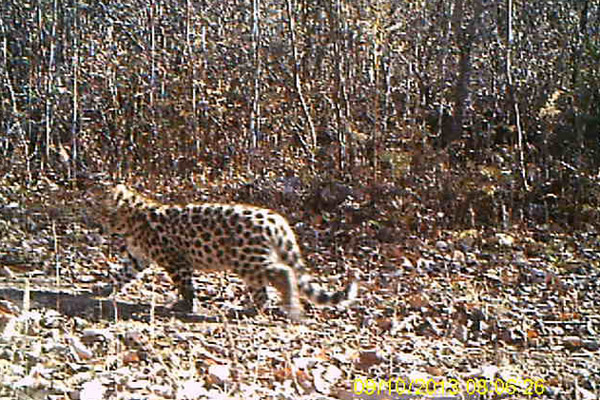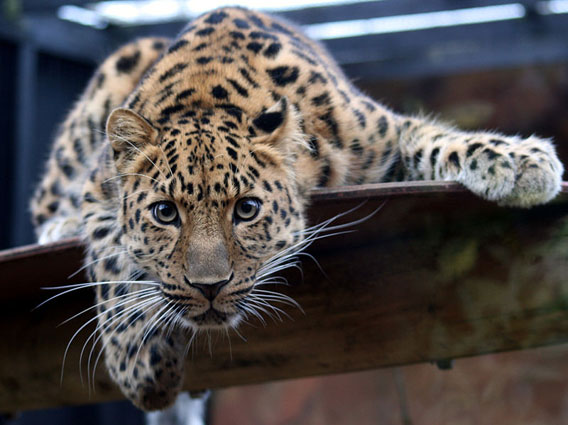Good news today about one of the world’s rarest mammals: camera traps in China’s Wangqing Nature Reserve have captured the first proof of breeding Amur leopards in the country, according to the Wildlife Conservation Society (WCS). The photos show a mother Amur leopard with two cubs. A recent survey by WWF-Russia estimated the total wild population of Amur leopards at just 50 individuals, but that’s a population on the rise (from a possible nadir of 25) and expanding into long-unused territory.
“This incredible find is important for two reasons,” notes Joe Walston, WCS Executive Director for Asia Programs. “Firstly, it shows that our current efforts are paying off but, secondly, it shows that China can no longer be considered peripheral to the fate of both wild Amur leopards and tigers.”
Amur leopards and Amur—or Siberian—tigers (Panthera tigris altaica) share much of the same ecosystem, and both big cats hunt large large hoofed prey like deer and boar. Yet both species were also pushed to the very edge of extinction by decades of poaching, until conservationists and countries responded. Amur leopards are currently listed as Critically Endangered by the IUCN Red List, while Amur tigers are considered Endangered with around 360 animals surviving in the wild.
Amur leopards were only confirmed in China two years also via camera trap. The animals hadn’t been photographed in China for over 60 years, though scientists suspected the cats had begun to cross back and froth between China and Russia. The Amur leopard family caught on camera in China are just 30 kilometers (18 miles) from the larger population in Russia. The photos were taken as a part of a camera trap program run by the Forestry Bureau of Jilin Province.
“With a few key decisions by the government, China could become a major sanctuary for the species,” Walston
Amur leopards have the thickest coat of any leopard subspecies and are the only one adapted to a snowy, frigid climate. Aside from populations in Russia and China, a few leopards may still survive in North Korea. The animal remains imperiled by poaching, road building, logging, prey decline, and low genetic variability.

Amur leopard cub following mom in China. Photo by: Forestry Bureau of Jilin Province.

Mother Amur leopard in China. Photo by: Forestry Bureau of Jilin Province.

Amur leopard cub. Photo by: Forestry Bureau of Jilin Province.

Captive young Amur leopard at the Colchester Zoo. Photo by: Keven Law.
Related articles
Snowy tigers and giant owls: conservation against the odds in Russia’s Far East
-WCS-Russia.150.jpg)
(05/28/2013) The Russian Far East is one of the wildest places on Earth: where giant tigers roam snow-covered forests and the world’s biggest owls stalk frozen rivers. Bordering northern China and North Korea, the forests of Primorye are known for the diversity of habitats, including coastal forests along the Sea of Japan, vast coniferous forests in the Sikhote-Alin mountains, and even steppe. These diverse ecosystems also makes the forests a hotspot for endangered species, including Amur tigers (Panthera tigris altaica), Blakiston’s fish owls (Bubo blakistoni), and one of the world’s rarest big cats, Amur leopards (Panthera pardus orientalis), which number only 30-50 animals.
Scientists capture one of the world’s rarest big cats on film (photos)

(05/21/2013) Less than a hundred kilometers from the bustling metropolis of Jakarta, scientists have captured incredible photos of one of the world’s most endangered big cats: the Javan leopard (Panthera pardus melas). Taken by a research project in Gunung Halimun-Salak National Park, the photos show the magnificent animal relaxing in dense primary rainforest. Scientists believe that fewer than 250 mature Javan leopard survive, and the population may be down to 100.
Amur leopard population rises to 50 animals, but at risk from tigers, poachers

(04/09/2013) In the remote Russian far east, amid pine forests and long winters, a great cat may be beginning to make a recovery. A new survey estimates that the Amur leopard (Panthera pardus orientalis) population has risen to as many as 50 individuals. While this may not sound like much, it’s a far cry from the a population that may have fallen to just 25 animals. Sporting the heaviest coat of any leopard, the Amur leopard largely hunts hoofed animals, such as deer and boar, in a forest still ruled by the Siberian tiger.
Chinese government creating secret demand for tiger trade alleges NGO (warning: graphic images)

(02/26/2013) The number of tigers being captive bred in China for consumption exceed those surviving in the wild—across 13 countries—by over a third, according to a new report by the Environmental Investigation Agency (EIA). The report, Hidden in Plain Sight, alleges that while the Chinese government has been taking a tough stance on tiger conservation abroad, at home it has been secretly creating demand for the internationally-banned trade. Few animals in the world have garnered as much conservation attention at the tiger (Panthera tigirs), including an international summit in 2010 that raised hundreds of millions of dollars for the vanishing wild cats.
Saving the Arabian leopard, the world’s smallest leopard

(01/14/2013) Today most people are more likely to associate Yemen with warfare and bizarre terrorism plots rather than wildlife. But Yemen is home to a surprising diversity of animals, including a population of the world’s smallest leopard: The Arabian leopard (Panthera pardus nimr). Native to the Arabian Peninsula, the Arabian leopard is today extremely rare — less than 200 animals are thought to survive in the wild. Despite the cat’s precarious position, there is relatively little local enthusiasm to protect a species that is widely seen as a threat to livestock. Nevertheless one man in Yemen is trying to boost the value of leopard in the eyes of local people. David Stanton, an American teacher living in Yemen, had devoted his life to saving the Arabian leopard.
Photos: Chinese leopard wins camera trap contest

(11/27/2012) The third annual BBC Wildlife Magazine Camera Trap Photo of the Year contest has produced some stunning and surprising images, including a snow leopard sticking its tongue out, a rare giant pangolin, and wrestling monitor lizards. But the winner this year was the perfect shot of a young leopard in China.